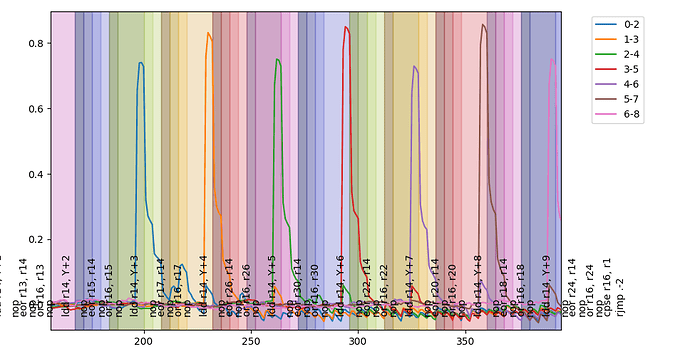Hi,
I’m doing some experimentation with the Chipwhisperer-lite regarding power analysis, in particular how single instructions affect the power consumption. Long story short I encountered a curious effect regarding the instruction ld: it seems that power consumption of two lds is correlated by the hamming distance of the final value in their registers.
The strange thing is that the correlation appears at steps of two: in order to explain this better take this code (it simply implements a constant time password checking algorithm)
75a: 80 93 05 06 sts 0x0605, r24 ; 0x800605 <__TEXT_REGION_LENGTH__+0x7de605>
75e: 00 e0 ldi r16, 0x00 ; 0
760: d9 a0 ldd r13, Y+33 ; 0x21
762: fa a0 ldd r15, Y+34 ; 0x22
764: 1b a1 ldd r17, Y+35 ; 0x23
766: ac a1 ldd r26, Y+36 ; 0x24
768: ed a1 ldd r30, Y+37 ; 0x25
76a: 6e a1 ldd r22, Y+38 ; 0x26
76c: 4f a1 ldd r20, Y+39 ; 0x27
76e: 28 a5 ldd r18, Y+40 ; 0x28
770: 89 a5 ldd r24, Y+41 ; 0x29
772: e9 80 ldd r14, Y+1 ; 0x01
774: de 24 eor r13, r14
776: 0d 29 or r16, r13
778: ea 80 ldd r14, Y+2 ; 0x02
77a: fe 24 eor r15, r14
77c: 0f 29 or r16, r15
77e: eb 80 ldd r14, Y+3 ; 0x03
780: 1e 25 eor r17, r14
782: 01 2b or r16, r17
784: ec 80 ldd r14, Y+4 ; 0x04
786: ae 25 eor r26, r14
788: 0a 2b or r16, r26
78a: ed 80 ldd r14, Y+5 ; 0x05
78c: ee 25 eor r30, r14
78e: 0e 2b or r16, r30
790: ee 80 ldd r14, Y+6 ; 0x06
792: 6e 25 eor r22, r14
794: 06 2b or r16, r22
796: ef 80 ldd r14, Y+7 ; 0x07
798: 4e 25 eor r20, r14
79a: 04 2b or r16, r20
79c: e8 84 ldd r14, Y+8 ; 0x08
79e: 2e 25 eor r18, r14
7a0: 02 2b or r16, r18
7a2: e9 84 ldd r14, Y+9 ; 0x09
7a4: 8e 25 eor r24, r14
7a6: 08 2b or r16, r24
7a8: 01 11 cpse r16, r1
7aa: ff cf rjmp .-2 ; 0x7aa <main+0xe4>
if I generate the correlation between couple of input bytes I obtain the following graph
(the entry at row i and column j indicates the correlation between the traces and input[i] xor input [j], instead in the diagonal the direct correlation with input[i]). The peaks appear at the position of the ld instructions.
Now my question is, is this a known effect, is there any literature regarding it?
Thanks for any feedback,
gp


